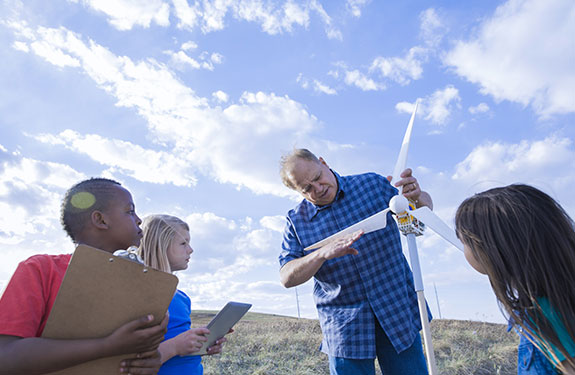
Problem-based learning (PBL): It’s all the rage. PBL is an innovative addition to modern K-12 pedagogy, but it can seem overwhelming for beginners. It doesn’t have to be, though.
PBL’s principal goal—meeting students where they are and putting them to work solving real-world problems—marks a significant shift from old educational models. Putting it into action unearths a host of practical challenges, from finding “real” real-world questions to ensuring accurate and adequate assessments.

1. Finding authentic problems
It can be difficult to know the kinds of problems that work best with PBL, but one thing’s for sure: Instructors must avoid manufacturing false challenges just to make them fit a predesigned pedagogy. Students are quick to identify these manufactured issues, said Dr. Richard Charles, the STEM and Innovation office director of Cherry Creek schools in Denver, Colorado, in a recent GlobalMindED panel. Charles called authenticity a key quality in PBL.
But what does “authentic” look like? An article on PBL at Education World recommends assigning students to ask local business leaders, other groups doing PBL, or key members of the school or local community to suggest tangible real-world problems. Projects might include:
- Investigating and addressing causes of student absences.
- Increasing a business’s website traffic.
- Helping a community develop a historic walking tour.
Whatever you choose, make sure it’s a real problem and that students target their solutions to a specific audience who is willing to listen. Furthermore, it’s still essential that PBL link with your school’s curriculum and standards.
Having students gather potential problems themselves offers a key opportunity to increase their metacognitive awareness of course outcomes or standards. They can gather their problems and then defend them as applicable to curriculum by illustrating potential areas of learning in their project.
These discussions help ground PBL in pedagogical soil—ensuring that students understand that PBL is both personally invented and defined, but also deeply educational. It’s all about real problems, real solutions and real learning.
2. Confronting your own lack of knowledge
Whether we intend to or not, instructors grow accustomed to “sage” status. PBL can move us off the stage and make us uncomfortable because we might not know or understand the problems or technologies our students are dealing with. That’s a unique challenge to our preparations, because we can walk with our students into areas that expose our ignorance.
One significant challenge to preparing for PBL is ensuring students have proper research resources and are prepared to do their own research and connect with mentors, educator Brianne Gidcumb suggests. While it may be impossible to fully prepare for a PBL journey with students, Gidcumb says that sincere problems that are justifiably connected to curricular outcomes can make teachers more comfortable with the process. Sometimes it is enough for us to understand that the journey is connected to our curriculum.
3. Getting up to speed on PBL
It is also important to be educated on PBL. While it is becoming increasingly popular, not every district has a wealth of professional development resources to ensure that teachers are deeply educated in PBL. This should not stop you. In addition to collecting your own resources, consider alternative methods of professional development like Twitter chats, message boards, or online communities dedicated to PBL.
PBL doesn’t have to be lonely territory for instructors. You can explore the creation of instructional teams or other in-school connections. PBL provides opportunities for work across disciplines, which gives teachers a chance to unite in planning. Having a small cohort to discuss instructional challenges is essential.
4. Embracing effective failure
The potential for failure is not a downside of PBL. Indeed, failure presents an excellent opportunity to show students their actions have real-world consequences and that success is far from guaranteed.
Students won’t be able to design clear solutions to every problem they encounter. Industries understand that failure is sometimes a piece of the process; schools should have the same approach. Students need to understand that failure is not only accepted out there in the real world: It’s often a key part of the process.
Communicating the PBL process to students is key. They must see PBL as an opportunity to unite real-world issues with academic outcomes and standards. They must understand PBL isn’t an exam and perfection is not the goal.
Instructor Carmel Schettino identifies communication as a key challenge to PBL. In a blog post for the National Council of Teachers of Mathematics, she identifies two key pieces of the assessment process for PBL:
- Instructors must consistently engage students to help them understand how their PBL work links back to their overall learning outcomes or course objectives.
- Students need opportunities to revise in their work so they can reflect on how PBL relates to their classroom assessments.
There are all sorts of ways to assess students’ success on PBL. Whatever you do, make sure you’re communicating in a way that ensures they understand the applicability of the work they are doing.
Though wading into unfamiliar teaching territory can be scary, keep in mind that problem-based learning is not new. It has been consistently used since the 1960s in medical schools. Adoption at the K-12 level can seem daunting, but the skills it imparts on students, both in connecting with curricular outcomes and in soft-skills like communication, frustration and effective failure, are essential in 21st century learners. Embrace PBL with verve and see every new challenge as ab opportunity for significant and measurable learning.
